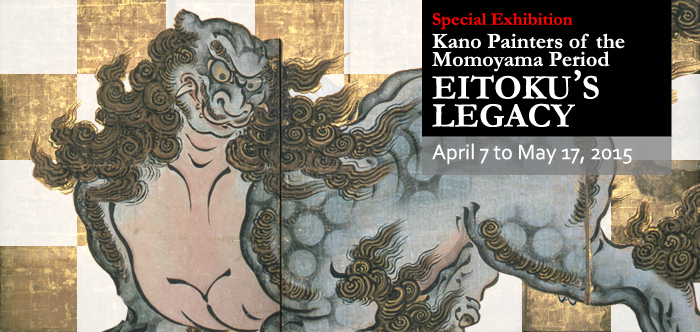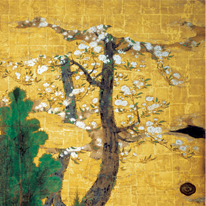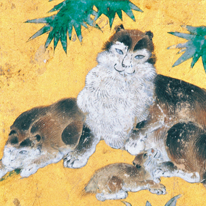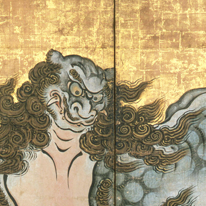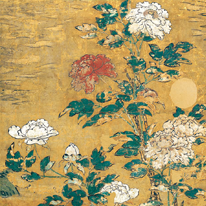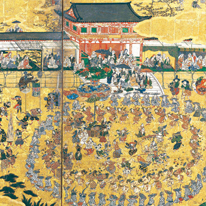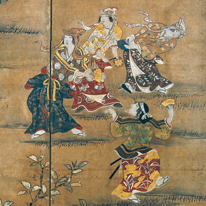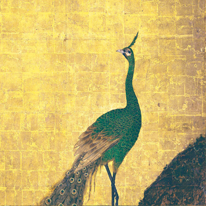General Information
| Exhibition Title | Kano Painters of the Momoyama Period: EITOKU'S LEGACY |
|---|---|
| Period | April 7 - May 17, 2015 |
| Venue | Meiji Kotokan (The Main Hall) |
| Transportation | JR, Kintetsu Railway, Keihan Railway, Hankyu Railway, City Bus / Map |
| Special Exhibition Hours | 9:30 a.m.-6:00 p.m. (Entrance Until 5:30 p.m.) Fridays 9:30 a.m.-8:00 p.m. (Entrance Until 7:30 p.m.) |
| Closed | Closed on Monday *Except May 4 |
| Special Exhibition Admission |
Adult \1,500 (\1,300) Univ. Student \1,200 (\1,000) High School Student \900 (\700) Admission is free under middle school students. *(Fees in parentheses for groups of twenty or more) *The fees include admission to the Collections Galleries. |
| Organized by | Kyoto National Museum, THE MAINICHI NEWSPAPERS, NHK Kyoto, NHK PlanNet Kinki |
| Cooperated by | Nozaki Insatsu Shigyo Co., Ltd., DAIWA HOUSE INDUSTRY CO.,LTD, OBAYASHI CORPORATION |
| Sponsored by | Nippon Kodo |
| Supported by | Kyoto Convention Bureau |
Images from the Exhibit
2015 marks the 400th anniversary of the 1615 Siege of Osaka, after which the reins of Japanese political power transferred from the Toyotomi clan to the Tokugawa, changing the course of history for centuries to follow. During this time of political upheaval, not only warlords but also artists were engaging in cutthroat strategic competition for survival. The Kano school of painters, which had hitherto maintained close relations with political authorities, faced their greatest crisis ever in this turbulent age. The sudden death of their leader Kano Eitoku (1543–1590), the emergence of rival painter Hasegawa Tōhaku (1539–1610), and a shifting political landscape made this one of the most precarious situations the Kano school had ever faced, and one requiring tough decisions by its artists.
This exhibition focuses on the years following Eitoku's death, centering around the Keichō era (1596–1615). Featuring painted masterworks by Eitoku's successors, it traces the changes in aesthetic tastes from bold dynamism to lavish splendor, and eventually to the restrained chic favored by Tokugawa rulers.
How did the Kano manage to hold their ground and even boost their standing as official painters to the Edo shogunate in the midst of such massive upheaval? In this special exhibition, the history of the Kano school's existential fight is elucidated through brilliant works of art, along with explanations of their historical contexts and of the various figures with whom they were associated.
Masters of Momoyama Painting: Eitoku’s Successors
Kano Mitsunobu (1565– 1608), Eitoku’s Successor
As Eitoku’s oldest son, Mitsunobu was thrown into a position of leadership of the Kano school when his father died suddenly in 1590. While Mitsunobu also worked in Eitoku’s grandiose mode, but his own style reveals a more delicate elegance imbued with qualities of yamato-e painting. Masterworks include the brilliant The Tale of Genji screens evoking classical courtier culture, along with his Flowering Trees of the Four Seasons sliding door panels, made on commission of Toyotomi Hideyori (1593–1615).
Kano Sōshū (1551–1601): Eitoku’s Shadow Warrior
Eitoku's younger brother by eight years, Sōshū worked in a dynamic style that faithfully maintained the aesthetics of his older brother's oeuvre. When Eitoku left Kyoto to produce paintings for Azuchi Castle on the order of warlord Oda Nobunaga, he left Sōshū in charge of the Kano headquarters in Kyoto, revealing the extraordinary confidence that Eitoku placed in his brother.
Kano Sanraku (1559–1635): Founder of the Kyoto Kano School
Sanraku was born the son of a retainer to the Asai clan who later served the Toyotomi. Upon the recommendation of Toyotomi Hideyoshi, Sanraku was accepted as disciple of Eitoku. After the demise of the Toyotomi, Sanraku became a target of the Tokugawa shogunate, but he was saved through the intercessions of priest and calligrapher Shōkadō Shōjō and others. He is renowned as the forefather of the Kano school’s Kyoto branch and based his artistic activities out of the capital.
Kano Takanobu (1571–1618): Mainstay of the Kano School after Mitsunobu's Death
Eitoku's second son Takanobu served as head of the Imperial Court Painting Bureau. After the death in 1608 of his older brother Mitsunobu, he supported the Kano school and oversaw the training of Mitsunobu's young son Sadanobu. He is also known for having raised the three artists who would form the center of the Kano school in Edo: Tan'yū, Naonobu, and Yasunobu.
Kano Naizen (1570–1616): Official Painter to the Toyotomi Clan
The son of a retainer to warrior general Araki Murashige of Setsu province, Naizen studied under Eitoku's father Kano Shōei (1519–1592). He later gained the trust of warlord Toyotomi Hideyoshi and his son Hideyori and became an official painter to the ruling Toyotomi clan. Naizen is also said to have been teacher to the painter Iwasa Matabei. He produced the fascinating Toyokuni Festival screens on the order of Hideyori. This work depicts a festival honoring the seventh anniversary of Hideyoshi's death, with imposing crowds of dancers in front of the Great Buddha Hall (Daibutsuden) at Kyoto's Hōkō-ji Temple.
Kano Naganobu (1577–1654): First Kano Painter to Serve the Tokugawa Shogunate
Eitoku's brother Naganobu was thirty-four years his junior. Naganobu became an official painter to the Tokugawa shogunate early on and used this seniority to facilitate the transfer of Kano Tan'yū and his two brothers to Edo, the seat of the new military government. Merrymaking under the Cherry Blossoms, famously used on a Japanese postage stamp, is his best known work and depicts with lively brushwork a scene of beautiful female dancers dashingly attired in male garb.
Kano Tan'yū (1602–1674), Precocious Wonder
The eldest son of Takanobu, Tan'yū was first granted audience with Tokugawa Ieyasu and his son Shogun Tokugawa Hidetada at the age of eleven (by the former Japanese system of counting age). At thirteen, his reputation was cemented when he was declared to be "a reincarnation of Eitoku" after painting in front of Hidetada. By his twenties, he was reigned supreme over the Kano school. Peacock and Pine is part of an ensemble of paintings produced for the Ninomaru Palace, newly refurbished in Nijō Castle by Shogun Tokugawa Iemitsu. While boasting massive scale, these paintings also exhibit in their compositions an intentionally understated chic—indicating that Edo period aesthetics had arrived. At the time, Tan'yū was twenty-five years old.











